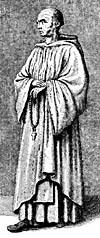< Previous | Contents | Next >
Rufford Abbey
 |
| Cistercian monk. |
This abbey, dedicated to the Blessed Virgin, faced the main road, about a mile or so south of Ollerton in the centre of the Sherwood Forest area, and was founded in 1146 by Gilbert de Gand, Earl of Lincoln, for monks of the Cistercian Order, the only house of that Order in our county. The Cistercian monk was dressed in white with a white scapular.
The Cistercian Order was founded in 1098 at Citeaux by St. Robert of Molesme, and when he returned to Molesme he was succeeded by Alberic and then by Stephen Harding, an Englishman who was mainly responsible for drawing up the Rule under which the Cistercians lived. The great growth of the Order is, however, attributable to St. Bernard of Clairvaux who joined that daughter house of Citeaux in 1112, and by the time of his death in 1153 the Cistercians had 330 houses. The formation of this Order was in effect a second revival, instituted like that of the Cluniacs because of a desire to adhere more closely to the principles laid down at Monte Cassino by St. Benedict. They were the first to organise themselves in the form of a corporation or Order in the sense in which the word is now used. Their mode of life was austere and lived in solitary places, and prevented them from becoming popular. The superiors met once a year at Citeaux but were otherwise independent. One of their houses was at Tilty, but the Marchioness of Dorset made herself so unpleasant to the abbots that three of them resigned in quick succession although one of the three soon married. Surely the triumph of hope over experience.
The monks of this Order were great farmers and specialised in sheep and became wealthy by the sale of their wool, and some authorities go so far as to say that they laid the foundation of the great wool industry which meant so much to England till late in the eighteenth century. The Cistercians did not originate and monopolize the wool industry in England, as other Orders had big flocks of sheep, but they were the largest wool-growers and produced the finest fleeces for the export market.
Here again there is little to record beyond the everyday happenings which are not worth repeating, except that Edward I and Queen Eleanor visited Rufford just before the Queen died in 1290. The Abbots were often authorised to fell and sell timber. The allegations made by Legh and Layton when they visited Rufford in 1536 against the abbot and certain monks were grave enough, but knowing these two gentry we can almost certainly ignore them. The monastery was suppressed in 1536 and the number of monks at that time is unknown, but is not likely to have exceeded twenty. The net annual value was £80. Thomas Doncaster, the last abbot, was granted a pension of £25 per annum notwithstanding the allegations made against him by Legh and Layton, but his pension was withdrawn on his appointment as Rector of Doncaster soon after his abbey was closed. Except the crypt under the present abbey, nothing now remains of the former abbey, although late in the nineteenth century one of the monks' tables and the tombstone of a monk who had died in 1309 were shown to visitors.
 |
| The Crypt, Rufford Abbey. |
The Victoria County History states that Rufford was granted by the king to the Earl of Shrewsbury in 1537, but Dugdale states that it was demised to Sir John Markham, Kt., under the Great Seal of the Court of Augmentations in 28 Hen. VIII (1536-1537), but that in the next year the king exchanged the site and other lands with George, Earl of Shrewsbury for certain castles, lordships and manors in Ireland.
